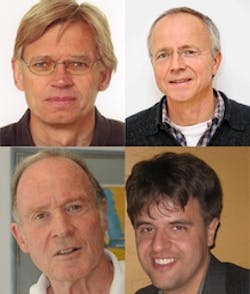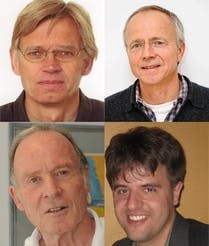Award honors pioneers of optogenetics
The Gertrud Reemtsma Foundation (Cologne, Germany) has awarded the K. J. Zülch Prize 2012 to four scientists who initiated and were instrumental in promoting optogenetics, which has made its mark in neuroscience and other biomedical applications.
The winners are: Ernst Bamberg of the Max Planck Institute of Biophysics (Frankfurt, Germany); Karl Deisseroth of Stanford University (Stanford, CA); Peter Hegemann of Humboldt University (Berlin, Germany); and Georg Nagel of the University of Würzburg (Würzburg, Germany).
Hegemann began to study the light perception of algae back in 1985 when he was working at the Max Planck Institute of Biochemistry (Martinsried, Germany). From 1995 onwards, Nagel and Bamberg at the Max Planck Institute of Biophysics succeeded in transferring different bacterial rhodopsins to frogspawn and human kidney cells, as well as in describing their electrophysiological properties. Between 2002 and 2003 Hegemann, Nagel, and Bamberg were able to demonstrate a remarkable property of algal rhodopsins: By transferring the rhodopsin gene to egg cells of the clawed frog, they found that the algal rhodopsins unify the light receptor and ion channel in a single protein. When blue light is incident, the protein channel becomes permeable for protons and positive potassium and sodium ions. The cell potential is therefore shifted towards the positive. The algal rhodopsins, called channel rhodopsins by the researchers, therefore differ from many other light-sensitive proteins such as rhodopsins in the human eye, which do not have their own directly light-activated ion channel.
Taking these results as their basis, various groups of researchers throughout the world began to use the channelrhodopsins as tools to investigate cells. Researchers, including the three pioneers, thus activated channelrhodopsins in the nerve cells of the nematode C. elegans (together with Alexander Gottschalk, University of Frankfurt) and in hen embryos and mice (together with Stefan Herlitze, University of Bochum). With channelrhodopsin-2 and halorhodopsin, it proved possible to control the mobility of the nematode, for example, as halorhodopsin "pumps" negatively charged chloride ions into the nerve cell after activation with yellow light. It thus shifts the cell potential further towards the negative and inhibits the cell. This allowed the nerve cells of the worm to be activated with blue light and deactivated with yellow light.
Deisseroth also recognized at an early stage the enormous potential of the channelrhodopsins for neuroscience, as the activity of nerve cells is based on the influx of sodium ions (which also flow through channelrhodopsin). In 2005, together with Nagel and Bamberg, he transferred channelrhodopsin-2 into nerve cells of the brains of rats, and was thus able to use optogenetics to trigger action potentials for the first time. Moreover, he also succeeded in activating channelrhodopsins in the brains of free-moving rats. He did this by conducting the light through glass-fiber cables directly into the brain. This enabled him to undertake investigations in a variety of animal species as to how nerve cells generate behavioral patterns such as movement, fear, or social behavior, and how learning and memory processes occur.
Optogenetics has also been useful in investigating neurological diseases such as epilepsy, Parkinsonâs disease, depression, and age-related blindness. Genetically modified animals that display disease symptoms similar to human symptoms and which have been provided with channelrhodopsin or halorhodopsin genes are important scientific tools. The objective is to use light to activate or deactivate nerve cells in the brain or in the eye of the animals in a controlled way. The intention is to remove the relevant disease phenomena or allow mice that are blind due to a genetic defect to regain their sight. The successful animal experiments open up possibilities for biomedical applications. For example, in September 2011, a major pharmaceutical company signed a license agreement for the patent of Bamberg, Hegemann, and Nagel for exploiting channelrhodopsins for gene therapy of age-related blindness.
The four researchers honored by the Gertrud Reemtsma Foundation are also working to further improve channelrhodopsins for optogenetics. This requires biophysical and biochemical investigations for the more detailed understanding of the molecular mechanism of the channels. The scientists have already described variants that manage with less light, react more rapidly, and are sensitive to different light wavelengths.
-----
Follow us on Twitter, 'like' us on Facebook, and join our group on LinkedIn
Laser Focus World has gone mobile: Get all of the mobile-friendly options here.
Subscribe now to BioOptics World magazine; it's free!

